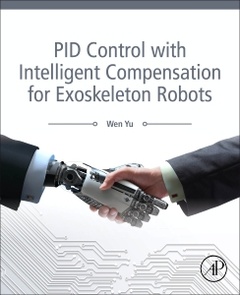PID Control with Intelligent Compensation for Exoskeleton Robots
Auteur : Yu Wen

PID Control with Intelligent Compensation for Exoskeleton Robots explains how to use neural PD and PID controls to reduce integration gain, and provides explicit conditions on how to select linear PID gains using proof of semi-global asymptotic stability and local asymptotic stability with a velocity observer. These conditions are applied in both task and joint spaces, with PID controllers compensated by neural networks. This is a great resource on how to combine traditional PD/PID control techniques with intelligent control. Dr. Wen Yu presents several leading-edge methods for designing neural and fuzzy compensators with high-gain velocity observers for PD control using Lyapunov stability.
Proportional-integral-derivative (PID) control is widely used in biomedical and industrial robot manipulators. An integrator in a PID controller reduces the bandwidth of the closed-loop system, leads to less-effective transient performance and may even destroy stability. Many robotic manipulators use proportional-derivative (PD) control with gravity and friction compensations, but improved gravity and friction models are needed. The introduction of intelligent control in these systems has dramatically changed the face of biomedical and industrial control engineering.
1. Preliminaries2. Stable PID Control and Systematic Tuning of PID Gains3. PID Control in Task Space4. PD Control with Neural Compensation 5. PID Control with Neural Compensation6. PD Control with Fuzzy Compensation7. PD Control with Sliding Mode Compensation8. PID Admittance Control in Task Space9. PID Admittance Control in Joint Space10. Robot Trajectory Generation in Joint Space11. Appendix - Design of Upper Limb Exoskeletons
Biomedical engineers, researchers in biomechatronics, biomechanics, robotics, biotechnology, engineering in medicine, mechanical and electrical engineering, health science and technology, as well as students in undergraduate and graduate-level courses in biomechatronics
- Discusses novel PD and PID controllers for biomedical and industrial robotic applications, demonstrating how PD and PID with intelligent compensation is more effective than other model-based compensations
- Presents a stability analysis of the book for industrial linear PID
- Includes practical applications of robotic PD/PID control, such as serial sliding mode, explicit conditions for linear PID and high gain observers for neural PD control
- Includes applied exoskeleton applications and MATLAB code for simulations and applications
Date de parution : 01-2018
Ouvrage de 234 p.
19x23.3 cm
Thèmes de PID Control with Intelligent Compensation for... :
Mots-clés :
<; p>; PID control; robot; neural networks; fuzzy systems; sliding mode control; stability; exoskeleton; high-gain velocity observer; task space; PID tuning<; /p>



